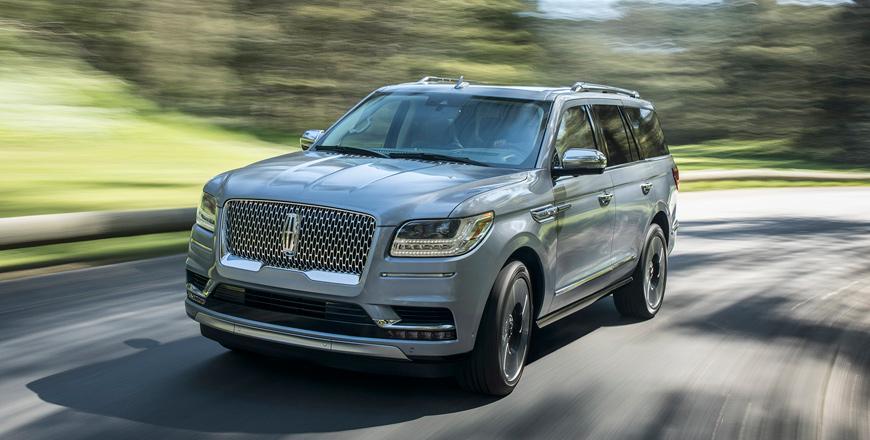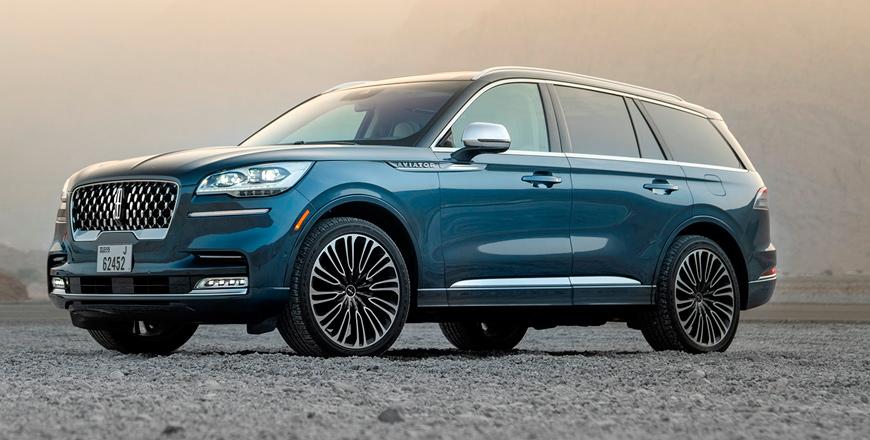You are here
Lincoln Navigator: living large
By Ghaith Madadha - Feb 04,2019 - Last updated at Feb 04,2019

Photo courtesy of Lincoln
With emphasis on high-end materials, refined, comfort and new technology, the latest Lincoln Navigator is a crucial part of redoubled effort by Lincoln to recapture the luxury and glamour it enjoyed in its 1960s heyday. Launched for 2018 and sporting a new design language similar to the brand’s Continental flagship saloon and powered by Lincoln’s most powerful engine yet, the Navigator competes in the full-size premium SUV segment against its traditional Cadillac Escalade rival, and others including the Infiniti QX80, Lexus LX570 and Mercedes-Benz GLS-Class.
Imposing impression
As imposing as ever with its hulking size, height, prominent chrome detailing and big grille, the new Navigator is, however — and like its Ford Expedition sister — somewhat of a design departure from its predecessor. Ditching the previous model’s low waistline, airy big glasshouse and high roofline, the Navigator now adopts a more contemporarily hunkered down look with high waistline and slightly descending waistline for a smaller glasshouse and slightly reduced visibility. This, however, is well compensated for by parking sensors, cameras and blind spot warning system.
A new model rather than update, the Navigator now incorporates more prominently ridged side character lines and better integrated full length rear lights. In front, it features a high and long bonnet, and new fascia with wide deep-set mesh grille and LED headlights in place of the outgoing model’s split grille design. Sharing new aluminium body construction with the Expedition, the Navigator sheds 90kg over its predecessor, which yields fuel efficiency, performance and handling ability dividends. Meanwhile, steel remains in use for its rigid chassis frame.
Quick cruiser
Tuned to produce an additional 50BHP over its less luxurious Expedition sister, the Navigator’s twin turbocharged direct injection V6 engine may not carry the Ecoboost name as it does over at Ford, but nevertheless makes this the most powerful Lincoln ever. Developing 450BHP at 5,500rpm and an immensely capable well of torque peaking at 510lb/ft available at just 3,000rpm, the Navigator is undoubtedly swift, with quick-spooling turbos with short gas flow paths ensuring eager off the line responses and scant little by way of turbo lag.
Deceptively quick, the Navigator is estimated to propel its substantial 2,655kg heft through the 0-100km/h benchmark in under 6 seconds. With good low-end response, flexibly versatile mid-range and punchy top-end, the Navigator is confident at speed and when overtaking, while its seamlessly smooth 10-speed automatic gearbox offers a broad range of ratios for performance, versatility, efficiency and refinement. However, its high level of refinement and sound insulation dull the sensation of speed, and initially one can easily and unintentionally creep above a desired cruising speed.
Cocooning comfort
Riding on a body-on-chassis platform mated with all-independent front double wishbone and rear multilink suspension like its Ford cousin, the Lincoln Navigator drives with a similarly settled and reassuring confidence. However, the Navigator is noticeably more refined in how it isolates one from sound, vibration and harshness, and rides with a cosseting and cocoon-like level of luxurious serenity. Available with adaptive suspension, the Navigator seemed to well-absorb and smooth out road imperfections, despite its vast optional 22-inch alloy wheels and somewhat low profile 285/45R22 tyres.
Only 105kg heavier than the equally large Expedition, the Navigator’s extensive insulation makes it feel bigger and heavier. An excellent long distance cruiser with light steering and comfortable suspension it may not be “sporty”, but pushed hard through corners it feels balanced, even with some body roll. More powerful, it is also easier to initiate a slight rear slide if feeding in too much power through a corner, but its four-wheel-drive and stability controls are quick to redistribute power and regain traction.
Practical and premium
Stepping in through big wide-swinging doors over automatically folding side running boards, one sits high and towering above most other vehicles with a commanding driving position. Designed with driver and passenger comfort utmost in mind, the Navigator is offered with three highly adjustable seat options, including 30-way adjustable Perfect Position front seats, which includes separate upper and lower back adjustability to allow a finely-tuned driving position. Cavernous inside with between 546- to 2,925-litre cargo capacity, the Navigator can be optioned as a seven- or eight-seater.
A practical premium vehicle that is extensively well-equipped with convenience, safety, driver assistance and infotainment systems including optional rear entertainment system, six USB ports, 10-device wifi, 20-speakers and more, the Navigator is luxurious in character and features quality leathers, woods and textures. Driven with the nautically-themed Yacht Club trim level and twin mid-row captain’s seats, the Navigator features light blue leather upholstery and whitewashed teak trim for an airy ambiance and distinctly retro character, while third row seats and access are designed to accommodate adults.
TECHNICAL SPECIFICATIONS
Engine: 3.5-litre, all-aluminium, twin-turbocharged, in-line V6-cylinders
Bore x stroke: 92.5 x 86.7mm
Compression ratio: 10:1
Valve-train: 24-valve, DOHC, variable valve timing, direct injection
Gearbox: 10-speed automatic, four-wheel-drive
Ratios: 1st 4.696; 2nd 2.985; 3rd 2.146; 4th 1.769; 5th 1.52; 6th 1.275; 7th 1.0; 8th 0.854; 9th 0.689; 10th 0.636
Reverse/final drive: 4.87/3.73
Power, BHP (PS) [kW]: 450 (456) [335] @5,500rpm
Specific power: 128.7BHP/litre
Power-to-weight: 169.5BHP/tonne
Torque, lb/ft (Nm): 510 (691) @3,000rpm
Specific torque: 197.6Nm/litre
Torque-to-weight: 260.2Nm/tonne
0-100km/h: under 6-seconds (estimate)
Length: 5,334mm
Width, including mirrors: 2,382mm
Height: 1,938mm
Wheelbase: 3,111.5mm
Track, F/R: 1,717/1,706mm
Overhang, F/R; 970/1,252mm
Headroom, F/M/R: 1,061/1,016/947mm
Legroom, F/M/R: 1,115/1,044/1,074mm
Shoulder room, F/M/R: 1,656/1,653/1,630mm
Hip room, F/M/R: 1,572/1,564/1,305mm
Luggage volume, behind 1st/2nd/3rd row: 2,925-/
1,628-/546-litres
Seating: 7/8
Fuel capacity: 89-litres
Kerb weight: 2,655kg
Towing capacity: 3,764kg
Steering: Electric-assisted rack & pinion
Turning circle: 12.43-metres
Suspension, F/R: Double wishbones/multilink, anti-roll bars, optional adaptive dampers
Brakes: 350mm ventilated discs
Tyres: 285/45R22
Related Articles
First launched in 2007 and revised for the current model year, the Ford Expedition proves that there’s plenty of life left in its long-runni
Touted as a giant leap forward for the iconic American manufacturer’s behemoth full-size family SUV offering the new Ford Expedition is the
Launched last year as a 2020 model, the Lincoln Aviator may play second fiddle to hulking full-size Navigator SUV flagship in the American l


















